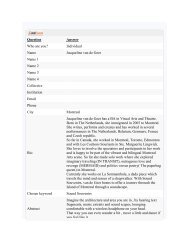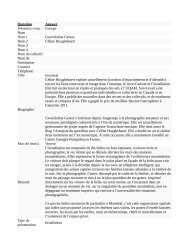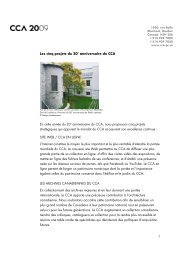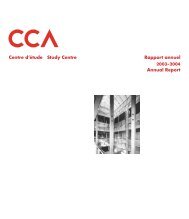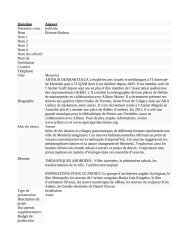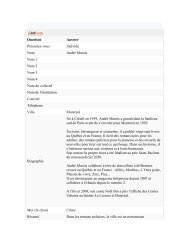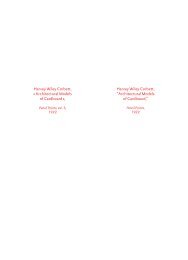Question Answer Who are you? Individual Name Cecilia Chen ...
Question Answer Who are you? Individual Name Cecilia Chen ...
Question Answer Who are you? Individual Name Cecilia Chen ...
Create successful ePaper yourself
Turn your PDF publications into a flip-book with our unique Google optimized e-Paper software.
Project Statement<br />
The city is a fountain. Certainly, Montréal is home to many fountains, ponds, water “features” and water<br />
events – some intentional – others less so. A city on an island in a larger archipelago, called Tiohtiake by the<br />
Mohawk, Montréal is a fountain. It shapes the waters that move through it from upstream to downstream.<br />
All its inhabitants (plant and animal) and all its matter (mineral, metal, synthetic and composite) act together<br />
to influence the way water moves through the city – as well as radically altering its biochemistry. Currently,<br />
Montréal as a fountain finds a rather everyday and ignoble outlet in the wastewater treatment plant at the<br />
downstream end of the island. With intense rainfall earlier this summer the city became a site of flash<br />
flooding as its limited and aging water infrastructures failed miserably to deal with a changing climate. Our<br />
urban infrastructures do not celebrate water – as all good city-fountains should! The intent of this project is<br />
to celebrate water in the city and to ask Montrealers to propose ways in which we might make the city a<br />
better fountain – an urban environment designed inclusively with water and its more-than-human generative<br />
force.<br />
What is a fountain? It is a conscious and jo<strong>you</strong>s expression of water. Well-known Roman examples<br />
such as the Trevi fountain celebrate the arrival of aqueducts in the city. This kind of fountain venerates its<br />
source with exubertant jets. But not all fountains celebrate water in the same way. Other, more<br />
contemporary fountains <strong>are</strong> given form by conscientious artists such as Basia Irland (see her Desert<br />
Fountain), artist and architect Maya Lin (see her many installations involving water, particularly her design for<br />
three phases of water in the Ecliptic park at Rosa Parks Circle in Grand Rapids, Michigan), and gh3<br />
Architects and Landscape Architects with their SWQF (Storm Water Quality Facility) in Toronto’s West<br />
Don Lands – a building that is also a fountain. Recent wastewater management lore has recognized the<br />
sophistication and complex biodiversity of restoring wetlands and adding meanders back to river courses.<br />
These <strong>are</strong> only some of the many inspiring examples of design approaches that celebrate water.<br />
Some Theoretical Background<br />
A recurring place and re-iterated articulation of water for many humans is now the city. These densely<br />
settled <strong>are</strong>as embody great risks and potentials in their intense socialized interactions with water. Waters<br />
move constantly between and through bodies, ecosystems and cities, enabling biological and meteorological<br />
transformations, including life, death, pollution and disease. Waters <strong>are</strong> always environmentally responsive<br />
and join us with the more-than-human into communities of sh<strong>are</strong>d waters. We need to understand our part<br />
in this hydrocommons. Consciously or not, we create the hydrocommons together with other humans,<br />
other creatures, multi-national corporations, industries and municipalities midst climate change. Waters<br />
shape and found cities even as cities influence and transform these same waters that in turn contribute to<br />
climatic patterns.<br />
By deliberately thinking about our relations to water – by thinking with water – we alter how we<br />
understand where we live and how we might build cities that truly respond to the hydrodynamic ethics<br />
entailed in living both upstream and downstream from many others. These hydrodynamics <strong>are</strong> obviously<br />
ecological, physical, geophysical, and meteorological – but they <strong>are</strong> also social, ethical, and political.<br />
Consider the architectural fabrics, systems, and complex bodies of cities. Cities shape how we live –<br />
from how we move within and through their actual constructions and in how we perceive what is valuable<br />
about the diverse and overlapping communities that they enable. To begin with, by irrigating the way we<br />
think and plan our cities, we necessarily place urban centres in relation to watersheds, rivers, lakes, aquifers,<br />
and regional infrastructures; we become aw<strong>are</strong> of the hydrophilic and hydrophobic bodies of plants, animals<br />
(including humans), gardens, parks, canals, roadways, buildings and the many sh<strong>are</strong>d places in-between.<br />
Current design and planning practices refer mostly to terrestrial property and political borders.<br />
Thinking cities with water deterritorializes or reterritorializes these practices critically and generatively – thus,<br />
enabling a way of thinking, planning and building that includes a more dynamic and complex systems-based<br />
approach to environment, biodiversity and urbanity. Where aspects of this environmentally and contextually<br />
City as Fountain Proposal for ABC : MTL – Canadian Centre for Architecture – C.<strong>Chen</strong> - 120731 . . . 2 of 5



